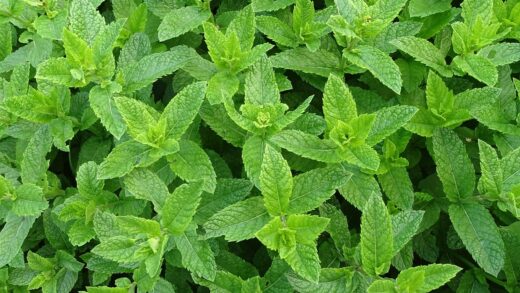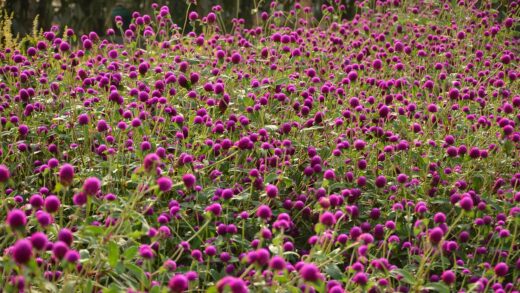Fuchsia, also known as lady’s eardrops or hummingbird fuchsia, is an exceptionally popular and attractive ornamental plant, so beloved by gardening enthusiasts for its vividly colored, uniquely shaped flowers. Originally from the mountainous, humid forests of Central and South America, as well as New Zealand, it prefers a cooler, moist climate. Its popularity is due not only to its beauty but also to its relatively easy cultivation, provided you are aware of its basic needs. With proper care, it tirelessly produces its wonderful flowers throughout the summer, the shape and color of which can vary प्लेटों depending on the variety, from elegant, bell-shaped to lush, double, ruffled petals.
The fuchsia family includes over a hundred species and several thousand cultivated hybrids, so everyone can find a specimen that suits their taste and garden. There are bushy, trailing, and even varieties that can be shaped like small trees, allowing for versatile use in gardens, balconies, and patios. The color of the flowers can range from white, pink, purple, red, to deep burgundy, often in combinations of two or more colors. The fuchsia not only has aesthetic value but also attracts pollinating insects, especially hummingbirds in its native land, thus contributing to maintaining the garden’s biodiversity.
Introduction and Popularity of Fuchsias
The fuchsia genus was named after the German botanist Leonhart Fuchs in the 17th century and has since enjoyed uninterrupted popularity among flower lovers. The main attraction of these plants lies in their incomparably beautiful inflorescences, which are often bicolor, with sepals and petals displaying different shades. The shape of the flowers can also be extremely varied, from the classic bell shape to more complex, double varieties. Among fuchsias, you find very small, dwarf varieties, as well as vigorously growing species that can develop into small shrubs, making them useful for many different gardening purposes.
One of the reasons for the fuchsia’s popularity is its versatility; it is excellently suited for hanging baskets, window boxes, pots, but can also be used as a border in flowerbeds or as a solitary plant. Particularly popular are the trailing varieties, which cascade waterfall-like from the container, creating a spectacular floral curtain. With proper care, fuchsias bloom for a long time, from late spring to early autumn, constantly producing new buds. This long blooming period makes them especially valuable in ornamental gardens.
The interest in fuchsias has also stimulated the imagination of breeders, thanks to which there are now several thousand different hybrids on the market. These hybrids differ not only in flower color and shape but also in growth habit, disease resistance, and cold tolerance. There are varieties that tolerate sunnier locations, although most fuchsias prefer semi-shaded, protected spots. Breeding work is constantly ongoing, so every year new, even more special and resistant varieties appear.
More articles on this topic
The fuchsia not only offers an aesthetic experience but also holds symbolic meaning in some cultures. It is often associated with elegance, grace, and love. Caring for the plant is for many a relaxing hobby that brings joy and a sense of accomplishment. It is also recommended for beginner gardeners, as, by observing a few basic rules, it rewards care with abundant blooms and can become a true jewel in any garden or balcony.
Choosing the Ideal Location
For the fuchsia, one of the most important factors is choosing the right location, as this fundamentally determines the plant’s healthy development and its willingness to flower. Generally, fuchsias prefer bright spots but protected from direct, scorching midday sun, i.e., semi-shade. Morning or late afternoon sun can be beneficial for them, but strong midday solar radiation can easily burn their leaves and flowers, and also lead to the plant overheating. A windowsill, a balcony facing east or west, or a sheltered corner of the garden with filtered light from a deciduous tree can be ideal for them.
Regarding temperature requirements, fuchsias prefer a cooler climate. For their optimal development, a temperature between 15 and 25 degrees Celsius is most favorable. Prolonged heat above 25-28 degrees Celsius can cause stress to the plant, which can lead to reduced or complete cessation of flowering, as well as leaf drop. It is therefore important during summer heat to provide them with a shady, airy place where the air temperature remains more moderate. Excessively hot and dry air also encourages the appearance of pests, such as spider mites.
Adequate air humidity is also crucial for the health of fuchsias, as in their natural habitat they live in environments with high humidity. Dry air, especially when grown indoors or during hot summer days, can cause the leaves to turn brown and dry out. To increase air humidity, you can spray the plant’s leaves with soft water, especially in the morning, or place a tray of water nearby, on which you sprinkle pebbles so that the pot does not stand directly in water. Grouping them can also help create a more humid microclimate.
More articles on this topic
Last but not least, fuchsias should be protected from strong wind and drafts. Wind can cause mechanical damage to the fragile shoots and flowers, and also dry out the plant and its soil too much. A sheltered terrace, a balcony corner, or a wind-protected part of the garden can offer them ideal refuge. If you keep them in hanging baskets, make sure the suspension is stable and the wind cannot swing the basket too much. A carefully chosen location contributes to your fuchsia remaining healthy and blooming for a long time.
The Tricks of Planting and Repotting
One of the cornerstones of successful fuchsia cultivation is the choice of the right planting substrate and the correct planting technique. Fuchsias prefer well-drained, loose soil rich in humus and with a slightly acidic to neutral pH (pH 6.0-7.0). Commercially available fuchsia soil or general potting mix can also be suitable, and it is worth further loosening it with a little perlite, peat, or sand for better aeration and drainage. It is important that the roots do not stand in stagnant water, as this can lead to root rot.
When choosing a planting container, consider the size of the plant and its growth vigor. Choose a pot or planter that provides enough space for root development, but is not disproportionately large, as this can lead to excessive soil moisture and slow drying. The container must absolutely have drainage holes at the bottom. The use of clay pots can be advantageous as their porous material aids soil aeration and the evaporation of excess moisture, but they require more frequent watering than plastic pots.
Repotting is usually necessary once a year, in early spring, before the growing season begins, or when the plant has outgrown its pot and the roots fill it. When repotting, carefully remove the plant from the old pot, shake off some of the old soil from the roots, and inspect the condition of the root system. Remove dead, damaged, or overly tangled root parts with sharp, sterilized pruning shears. Put fresh planting substrate in the new pot, place the plant so that the root collar is at the original height, and then fill the pot with soil, tamping it lightly.
After planting or repotting, water the plant thoroughly so that the soil is well moistened and the roots come into contact with the new substrate. For the first few weeks, keep the plant in a semi-shaded, protected place and avoid direct sunlight until it has strengthened. To reduce post-transplant stress, do not fertilize the fuchsia for at least 2-3 weeks, give the roots time to adapt to the new environment. Careful planting and timely repotting ensure the plant receives the necessary nutrients and adequate space for its development.
Watering Practices for Fuchsia Health
Proper watering of the fuchsia is crucial for healthy growth and abundant flowering, as this plant is particularly water-demanding, especially during the warmer months and the flowering period. The frequency and amount of watering should always be adjusted to environmental factors such as temperature, air humidity, light conditions, as well as the size of the plant and the material of the planting container. As a general rule, the fuchsia’s soil should be kept constantly slightly moist, but never let it dry out completely or stand in water for a long time.
The best way to determine when watering is needed is to check the moisture of the top 2-3 centimeters of soil with your finger. If this layer feels dry, it is time to water. Water more often with smaller amounts rather than rarely with large amounts of water, which can lead to root suffocation. For watering, preferably use room-temperature, soft water, such as rainwater or stale tap water, as hard, chlorinated water can damage the plant.
Overwatering can be at least as harmful as underwatering. Stagnant water causes root rot, which can lead to the plant’s demise. Signs of this can be yellowing, wilting leaves, soft, brown roots, and soil with an unpleasant odor. If you suspect overwatering, stop watering immediately and let the soil dry out. In severe cases, it may be necessary to repot the plant into fresh, dry substrate, removing the rotten root parts at the same time.
Signs of underwatering include wilted, drooping leaves and shoots, the dropping of flower buds, and a halt in growth. Although the fuchsia recovers relatively quickly if the water shortage is addressed in time, prolonged drought can cause permanent damage. In summer, during high heat, it may need to be watered twice a day, especially specimens in smaller pots or hanging baskets. Evening or early morning hours are most suitable for watering, so that the water has time to be absorbed and evaporation loss is reduced.
Nutrients and Fertilization: The Secret to Abundant Blooms
The fuchsia, as an intensively growing and profusely blooming plant, requires a regular supply of nutrients to be able to display its full splendor. During the flowering period, from spring to autumn, it is advisable to fertilize it weekly or fortnightly with a balanced, water-soluble complex fertilizer. Choose a preparation that contains the necessary macronutrients (nitrogen, phosphorus, potassium) and micronutrients (iron, magnesium, manganese, etc.). Phosphorus is particularly important for abundant flower production, while nitrogen increases green mass, and potassium improves general resistance and the color intensity of the flowers.
It is important that the fertilizer solution is always applied in the dilution recommended by the manufacturer and never onto dry soil, as this can burn the roots. First, water the plant with clean water and then apply the fertilizer solution. An excessive intake of nutrients can be at least as harmful as a deficiency; it can cause salt accumulation in the soil, which can damage the roots and weaken the plant. If you are unsure, it is better to use a more dilute solution more often.
Nutrient deficiency can manifest in various symptoms. Nitrogen deficiency, for example, causes yellowing of the leaves, especially the lower, older leaves, and weak growth. In case of phosphorus deficiency, flowering may be sparse, and the leaves may turn dark green, possibly with a purple tinge. Potassium deficiency can be indicated by browning and drying of the leaf edges and a general weakness of the plant. In case of iron or magnesium deficiency, chlorosis, i.e., yellowing between the veins, may appear on the younger leaves, while the veins remain green.
At the end of the growing season, in autumn, gradually reduce the frequency of fertilization and stop it completely during overwintering, as the plant enters dormancy and does not need extra nutrients. In spring, with the appearance of new shoots, you can resume the regular supply of nutrients, initially with a more dilute solution and then gradually increasing the concentration. A proper supply of nutrients ensures that your fuchsia will be healthy, vigorously growing, and will abundantly produce its wonderful flowers.
Pruning and Shaping: For a Beautiful and Healthy Plant
Regular pruning of the fuchsia is essential for the plant to develop a bushy, lush habit, bloom profusely, and maintain its aesthetic form. Pruning stimulates the formation of new shoots, on which the flowers typically appear, thus directly contributing to increasing the flowering potential. In addition, pruning helps to remove aged, diseased, or damaged plant parts, thereby improving the plant’s overall health and aeration, which reduces the risk of fungal diseases developing.
The main pruning period is usually in early spring, after the frosts have passed, but before intensive growth begins. Then, the woody shoots can be cut back by as much as half or a third, depending on the shape and size you want to achieve. Weak, thin shoots should be removed completely. After pruning, the plant will produce vigorous new shoots. For fuchsias that have been overwintered, this spring pruning is particularly important for renewal.
Even during the growing season, minor corrective pruning, known as pinching, may be necessary. When the new shoots reach 4-6 pairs of leaves, the shoot tip can be pinched, which stimulates the plant to further branching. This process can be repeated several times at the beginning of the season to obtain a truly dense, compact bush. Faded flowers and forming seed pods should also be regularly removed, as this encourages the plant to produce new flowers instead of spending its energy on seed maturation.
The pruning technique may vary slightly depending on the type of fuchsia. For bushy varieties, the goal is to create a dense, rounded shape, while for trailing varieties, it is important to encourage long, cascading shoots, but even here it is worth pinching the shoot tips for a lusher appearance. When training a fuchsia as a standard, the side shoots must be regularly removed from the trunk, and the crown shaped to the desired form. Always use clean, sharp pruning shears or a knife for pruning so that the cut surfaces are smooth and heal quickly.
Fuchsia Propagation Step-by-Step
Fuchsia propagation is relatively simple, most commonly done by semi-hardwood cuttings, which allows you to grow new plants from your favorite varieties or rejuvenate old specimens. The best time to take cuttings is late spring or early summer, when the plant is actively growing and the shoots are sufficiently strong but not yet fully woody. Cuttings rooted at this time have enough time to strengthen before autumn arrives.
To prepare cuttings, choose a healthy mother plant free from diseases and pests. With a sharp, sterile knife or pruning shears, cut 8-10 cm long shoot tips, preferably just below a leaf node. Remove the lower leaves from the cut cuttings, leaving only the top 2-4 leaves to reduce transpiration. If the remaining leaves are too large, you can further reduce water loss by halving them. It is advisable to dip the cut surface in rooting hormone, which promotes root formation, but this is not absolutely necessary.
The prepared cuttings can be planted directly into moist, loose potting mix, for example, a mixture of peat and perlite, or you can first root them in water. If planting in soil, use small pots or propagation trays and place the cuttings about 2-3 cm deep in the substrate. After planting, lightly firm the soil around the cuttings and then water them gently. To ensure high air humidity, cover the pots with transparent plastic film or the cut-off top of a plastic bottle, but ensure regular ventilation to prevent mold.
Keep the cuttings in a bright, but protected from direct sunlight, warm (approx. 18-22 degrees Celsius) place. Keep their soil consistently slightly moist. Rooting usually occurs within 2-4 weeks, which is indicated by the appearance of new shoots. If you have rooted them in water, transplant them into suitable potting mix once the roots are 1-2 cm long. Gradually acclimate the young, rooted plants to external environmental conditions before placing them in their final location.
Protection Against Common Diseases and Pests
Fuchsias, although relatively resistant plants, are unfortunately not immune to various diseases and pests, especially if the growing conditions are not optimal. One of the most common problems is fungal diseases, such as grey mold (Botrytis cinerea), which primarily attacks the plant in damp, cool weather and in poorly ventilated places, forming a grey, powdery coating on leaves, stems, and flowers. For prevention, it is important to ensure adequate spacing between plants, avoid overwatering, and ensure good air circulation. In case of infection, remove the affected parts immediately and, if necessary, apply a fungicide spray.
Fungi that cause leaf spots can also appear, especially in humid environments. These diseases cause spots of various sizes and colors on the leaves, which can later dry out and fall off. Prevention here is also based on good hygiene practices, such as removing fallen leaves and ensuring adequate plant ventilation. Fuchsia rust is another fungal disease that causes orange or brown pustules on the underside of the leaves. In case of severe infection, the leaves turn yellow and fall off. Prevention and control are similar to those for other fungal diseases.
Among pests, aphids, spider mites, and greenhouse whiteflies can cause the most problems. Aphids usually settle on young shoot tips and on the underside of leaves, weakening the plant by sucking its sap and excreting honeydew, which attracts ants and promotes the development of sooty mold. Spider mites are tiny, spider-like organisms that mainly reproduce in warm, dry conditions, forming fine webs on the leaves, which turn yellow, become bronze, and fall off. Greenhouse whiteflies are tiny, white, moth-like insects that also suck on the underside of leaves and can multiply rapidly.
In pest control, prevention is the most important: regularly inspect the plants and act immediately at the first signs. In case of a minor infestation, pests can be washed off with a jet of water or wiped with a damp cloth. The use of natural enemies, such as ladybugs (against aphids) or predatory mites (against spider mites), can also be effective. In more severe cases, the use of biological pesticides, such as potassium soap, neem oil, or specific insecticides, may be necessary. Always follow the instructions for use of pesticides and give preference to environmentally friendly solutions.
Overwintering Fuchsias: Preparing for the Cold Months
Most fuchsia varieties are not frost-hardy, therefore, in regions with cold climates, proper overwintering of the plants is necessary so that you can enjoy their flowers again the next season. Preparation for overwintering should begin already in autumn. Gradually reduce watering and stop fertilizing to help the plant prepare for the dormant period. Before the first frosts, but while the daytime temperature is still stably around 5-10 degrees Celsius, move the plants to a frost-free, cool space.
An ideal place for overwintering is a bright or dark, but definitely cool (5-10 degrees Celsius) space, such as an unheated veranda, a basement, a garage, or a stairwell. If it overwinters in a bright place, the plant can retain some of its leaves and will require less pruning in spring. In case of overwintering in a dark place, the plant will likely shed all its leaves, which is completely normal. In this case, you can prune the shoots more severely, even by half or two-thirds, to save space and prevent diseases. Before pruning, remove all withered leaves and flowers.
During overwintering, the fuchsia’s water requirement reduces to a minimum. Water them only enough so that their soil does not dry out completely; this is usually sufficient once or twice a month, depending on the humidity and temperature of the room. Overwatering can lead to root rot even during the dormant period. Regularly check the plants for signs of pests or diseases and, if necessary, take appropriate precautions. Good ventilation is important to prevent mold.
In spring, usually around March, when the days begin to lengthen and temperatures rise, gradually acclimate the fuchsias to warmer and brighter conditions. Initially, place them in a brighter, but still cool place, and begin to carefully increase the frequency of watering. At this time, you can also perform spring pruning, removing dead or weak shoots and shaping the plant. When the danger of night frosts has passed and the outdoor temperature is stably above 10 degrees Celsius, you can move them outdoors, initially to a shady, protected place, and then gradually acclimating them to the light conditions of their final location.




















